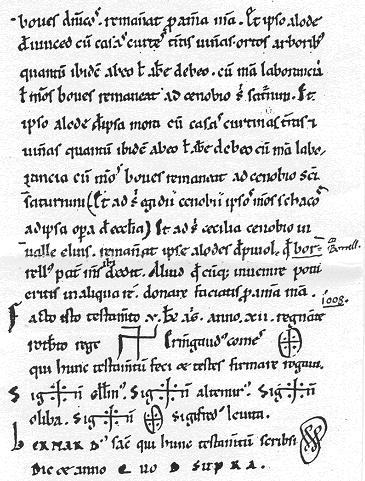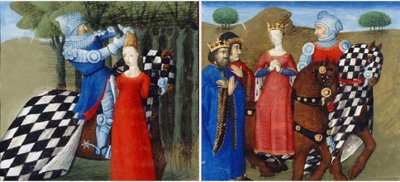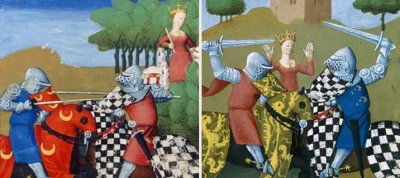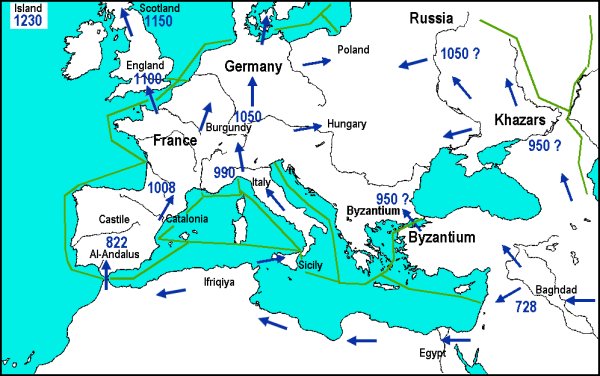Medieval European Chess
Chess in Middle Age was very different from what it is now. We would find it boring because it keeps almost unchanged the Muslim rules with their slow motions until the big revolution which occurred at the end of the 15th century in Valencia (or Salamanca?), Spain.
Middle Age was a different time, with an other spirit. Whatever the speed, no other game was more popular than Chess in that period in Europe.

SHORT DESCRIPTION
Two players, having 16
pieces each: 1 King (Latin : Rex) ![]() , 1 Queen (Regina)
, 1 Queen (Regina) ![]() , 2 Alfins (Alphicus)
, 2 Alfins (Alphicus) ![]() , 2 Knights (Eques)
, 2 Knights (Eques) ![]() , 2 Rooks (Rochus)
, 2 Rooks (Rochus) ![]() et 8 Pawns (Pedes)
et 8 Pawns (Pedes) ![]() .
.
The board was the standard 8x8 squares with alternated colors. In Middle Age, no convention ruled its orientation yet, so the angle square at the players' right could be either white or black.
However, the rule ordering that King should not start on his color was starting to be observed. Then white King on black square and vice-versa.

Starting setup
RULES
Rules are mostly those of Muslim Shatranj with some minor modifications. There were some evolutions and variations from one country to another. What is given here are the "Anglo-French long assizes" as they were played on both sides of the Channel from 12th to 15th century.
The regular moves of the King, Knight and Rook were the same than their modern counterparts, except that they were no castling but some special initial moves instead.
The Pawn moved and captured like nowadays. It promoted to a "Fierge" (Ferzia) (playing as a regular Queen) when reaching the last row, whatever the number of Queens already on the board.
The moves of the Queen and the Alfin were similar to the move of the Muslim Firzan and Fil, then much more limited that our modern Queen and Bishop. They could move diagonally only, 1 step for the Queen and 2 steps - jumping - for the Alfin.

Moves of Alfin and Queen
Special rules for first move:
- The Queen's leap: for her first move, the Queen could jump at the 2nd square vertically, horizontally or diagonally. From d1 she could jump on b1, b3, d3, f3 or f1. She could jump over an occupied square. She could not capture nor check or the opposite King making this jump. The Fierce obtained by Pawn's promotion had the same ability.
- The Pawn's double step: for its first move, the Pawn could make 2 steps straight ahead instead of one. The difference with the modern rule is that double step was generally forbidden after a first capture had occurred.
-
"En passant" capture : consequence of the preceeding rule, a Pawn which would step over a square under threat of an opposite Pawn, could be captured by this Pawn. The latest comes then on the square it controlled. This is already the modern rule of "en passant" capture, still applied today.
|
When this rule started is not exactly known. This rules was used in England and in Spain in the 15th century before the Valencian reform that created modern Chess |
- The King's leap: for his first move, the King could jump at the 2nd square vertically, horizontally, diagonally or like a Knight. From e1 he could jump on c1, c2, c3, d3, e3, f3, g3, g2 ou g1. He could jump over an occupied square but not over a square under threat by an opposing piece. He could not capture with this leap nor jump to escape a check. However, he could still leap if he had been put in check on the previous moves.
|
This move is the direct predecessor of the modern "castling" move |

Permitted first moves for the Pawn (on b2), the Queen
(on d8) and the King (on e1)
The were 2 ways of winning:
-
Checkmate the opposite King.
-
Bare the opposite King, leaving him isolated with all his army captured. (However this rule inheritated from Muslim Chess will be progressively abandonned).
Stalemate when the only possible move was putting the King in capture was considered as a draw.
The "assizes":
Every country had its own way of playing, called their "assizes".
-
Spanish assizes
-
A Pawn reaching the last row can be promotted only if his player as already lost his Queen. This rule which was based on moral ground (a King may not have more than one Queen) has been progressively abandonned.
-
The King can not leap on his first move if he has been checked before.
-
Stalemate count for half a victory for the player who blocks his adversary.
-
Bare King also counts for half a victory. However, if a player mates while taking the last opposite piece, it is considered as a complete victory.
-
-
Lombard assizes
-
On his first move, the King can leap even farther, on squares b1 or b2.
-
King and Queen can me moved together at their first move. This counts as 1 move.
-
En-passant capture is forbidden.
-
A bare King has not lost. The game continues until its end.
-
-
German assizes
-
King, Queen and one Pawn can make their first move together. This counts as 1 move.
-
King's leap is permitted to escape a check.
-
Pawn's double step is allowed for Kings', Queen's and Rooks' Pawns only.
-
HISTORY
Chess penetrated Europe through 2 ways: Spain and Sicily
Shatranj naturally followed the Arabic muslim armies which conquered North Africa and the largest part of the Iberian peninsula (modern Spain & Portugal) after crossing the Gibraltar straits in 711. The regretted great Chess historian, Ricardo Calvo, affirmed that Ziriab, a famous poet and musician, introduced Shatranj at the court of Abd ar-Rahmân in Cordoba in 822.
At that time, Spain was on the border between two civilizations, the Christian and Muslim spheras. However, that border was not hermetic. Many scholars, physicians, were going back and forth, visiting and staying in the schools and universities. Alliances, even marriages, linked sometimes a Christian count to a Moor prince against an other count or an other prince. Then, Chess was not long to be transported in the Northern marchs of Spain. This is well confirmed by archaelogy. Many set of pieces have been found, all displaying the typical Islamic shapes.
- In NW Spain, 4 ivory artifacts from Peñalba de Santiago attributed to San Genadio, friend of king of León Alfonso III (died in 936)
- 8 rock crystal pieces from Celanova (Galice), mentioned in a donation in 938.
- In NE Spain, the 3 pieces at San Millan de la Cogolla (La Rioja) given by Sanche III, king of Navarra, in 1033.
- The Ager set currently preserved in Lerida and in Kuwait.
Several wills in the family of the counts of Barcelona demonstrate that Chess had became popular in the Christian castles of Catalonia. In 1008 or 1010, Ermengol 1st, count of Urgell, donated his Chess along with other jewels to the monastery of Saint-Gilles, close to Nîmes (South of France). Ermessenda, daughter of the Count of Carcassonne and wife of Ramon Borell, brother of Ermengol and count of Barcelona, did the same at her death in 1058. Chess had crossed the Pyrenees!

Fragment of Ermengol's will (courtesy of Alejandro
Melchor)
Beside Spain, Sicily has constituted an other door for the penetration of Chess in Europe. Sicily was under Islamic rules since the 9th century. Developing rich relationships with Orient, Egypt and the Italian states, Sicily experienced a very advanced society where Christians were the majority and Islam was the rule. Normand knights conquered Sicily in the second half of the 11th century, while continuing the tradition of tolerance instituted by the Moors.
From Sicily, Chess entered Italy, illustrated by the findings of Venafro (Molise) which is now dated of the end of the 10th century.
The Queen on a bi-colored board: two European innovations
The first known European (Christian) Chess treatise is the Versus de scachis, a Latin poem dated from about 990. It might be of Italian origin and was found at the Einsiedeln monastery in Switzerland. This text clearly mentions that the board contains squares of 2 colors and that a Queen stands beside the King. Therefore, it is obvious that Christians did not understand the function of the Arabic Vizier (Ferz) who accompanied the Shah. Apart these two innovations, the rules remained those of the Muslim Shatranj.
Then, from the turn of the 10th to 11th century, Chess conquered the rest Europe, passing the Pyrenees from Spain and the Alps from Italy. In 1230, Chess was mentioned in Island.
Eastern Europe may have been reached from an other road: Chess was transmitted to the Khazars (a Turkish people having adopted Judaism), then to the Russians through the Varengians. This commercial road was used in the other direction to bring ... slaves to Byzantium or Baghdad.


Chess was another game during 500 years!
During 5 centuries, Chess played in Europe remained similar to Muslim Chess. The main difference was the checkered color of the board which became a popular symbol of the game, with a strong presence in heraldry, fine arts, painting and literature.
However, the pilgrim, crusader or merchant who would have engaged a game in Damascus or Cairo would not have met any difficulty to play. On the contrary, the modern player of today ignores everything of this period and would be unable to play according to these rules.
Nevertheless, Medieval Chess represents more than a mere prehistory for Chess. Never, never Chess has been more popular and more influential on the society than in this period!

The diffusion of Chess in Europe






